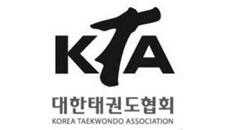- Tutorials
- Stances ( 서기 sogi )
- Horse Riding Stance ( 주춤서기 juchum-sogi )
Taekwondo 태권도Taekwondo Preschool
When you reach senior belt you are expected to guide the junior belts when they are beginning Taekwondo such as showing by example. To advance from one rank to the next, students typically complete promotion tests in which they demonstrate their proficiency in the various aspects of the art before a panel of judges or their teacher. View Taekwondo belt levels »

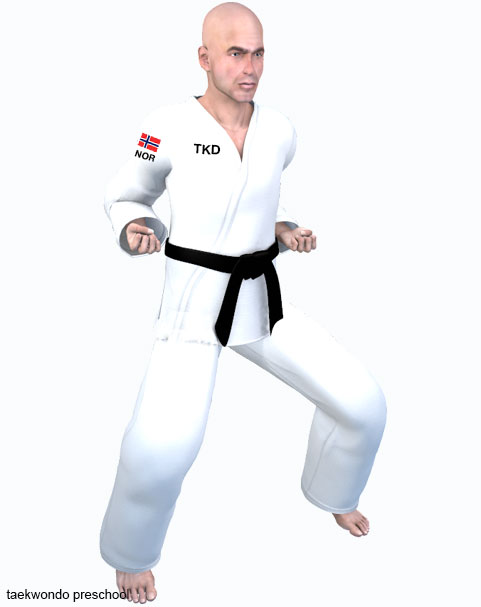
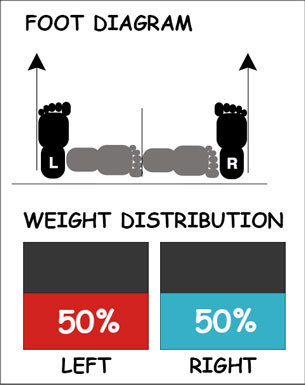


Horse-Riding Stance
주춤서기 juchum-sogi
Difficulty Level: Beginner Level Technique: Stance ( 서기 sogi )

In the Korean martial arts taekwondo, the Horse-Riding Stance ( 주춤서기 juchum-sogi ) is a beginner stance ( 서기 sogi ) generally used to focus practice on punches ( 지르기 jireugi ) and blocks ( 막기 makgi ). It is not similar to other stances ( 서기 sogi ) as the feet are placed much wider, about two-foot length's apart. Also, the knees ( 무릎 mureup ) are deeply bent and moved outwards away from the body. The shins ( 정강이 jeonggangi ) should be kept slightly perpendicular to the floor.
While practicing the stance ( 서기 sogi ), the hands ( 손 son ) are held in fists ( 주먹 jumeok ) on the hips at belt level, with the palms ( 손바닥 sonbadak ) facing up. When a punch ( 지르기 jireugi ) is thrown, the hand ( 손 son ) rotates 180 degrees to turn knuckles up before making contact to the target and the practitioner should shout ( 기합 kihap ) at the moment of impact.
The Horse-Riding Stance ( 주춤서기 juchum-sogi ) is most commonly performed with the Fist Punch ( 주먹 지르기 jumeok-jireugi ), Elbow Target Strike ( 팔굽 표적치기 palgup-pyojeok-chigi ), Single Knife Hand Outward Block ( 한손날 바깥막기 hansonnal-bakkat-makgi ), and the Middle Block ( 몸통막기 momtong-makgi ) in patterns ( 품새 poomse ). Also the stance ( 서기 sogi ) can be used to perform a Side Kick ( 옆차기 yeop-chagi ) to the side which will provide strong stability due to its low center of gravity.
General qualities that judges look for in any taekwondo practitioner include proper breathing technique and body control. The diaphragm must be engaged in deep breathing, shallow breathing concentrated in the upper abdomen results in raised shoulders and stressed muscles. The muscles of the body should be lightly relaxed in order to perform the stance ( 서기 sogi ) with fluidity, speed and grace. Muscles should only be tensed at the moment of imaginary impact in order to commute maximum power to any individual taekwondo technique.
In combat or self-defense ( 호신술 hosinsool ), it is used when being grappled in order to have a wider stance ( 서기 sogi ) and low center of gravity, giving stability and some control (compare with Judo and other wrestling defensive stances). The weight distribution of this stance ( 서기 sogi ) is 50/50 ratio and should be directed inwards. Short range punches ( 지르기 jireugi ) can be used on the target who is holding one around the waist when in this stance ( 서기 sogi ).
For other important uses, this stance ( 서기 sogi ) can be used as a stretch to the legs and groin as well. In strength training, the stance ( 서기 sogi ) like a squat, trains primarily the muscles of the thighs, hips and buttocks, quads, hamstrings, as well as strengthening the bones, ligaments and insertion of the tendons throughout the lower body.
In International Taekwondo Federation (ITF) and other Asian Martial Arts, this stance ( 서기 sogi ) is called 'Sitting Stance'. There are variations on how the stance is performed in other arts such as a wider and deeper stance.
Variations of Horse-Riding Stance ( 주춤서기 juchum-sogi )
- Parallel Riding Stance ( 나란히 주춤서기 naranhi juchum-sogi )
- Diagonal Riding Stance ( 모 주춤서기 mo-juchum-sogi )
- Inward Riding Stance ( 안쫑 주춤서기 anjjong-juchum-sogi )
- Forward Riding Stance ( 앞 주춤서기 ap-juchum-sogi )
Training Methods
How well one improves with training depends on several factors, such as the frequency it is engaged in, and the type of feedback that is available for improvement. If a student does not train often enough, reinforcement fades, and he or she is likely to forget what was learned.
When learning the stance ( 서기 sogi ), it is helpful to use a mirror to observe your stance ( 서기 sogi ) posture and fix your mistakes immediately. Initially, a student may need focused feedback from a certified Master Instructor ( 사범님 sabeomnim ); however, as they progress, they must develop the ability to self-assess the stance ( 서기 sogi ).
Minimum Level Requirement: White Belt (10th geup)
Difficulty of Technique
Taekwondo students of geup ranking learn the most basic techniques first, and then move on to more advanced and difficult techniques as they approach 1st Dan Black Belt. The more difficult the technique, the more practice may be needed for the purpose of improving or mastering it, as in the phrase 'practice makes perfect'. Every technique must display the requisite speed, balance, power and firmness to be realistically used as an attack or defense move.
* Please see a certified Master Instructor ( 사범님 sabeomnim ) for training. Proper guidance and instructions are needed to ensure safe training.
Promotion Tests
Students often undergo periodic testing and grading by their own Master Instructor ( 사범님 sabeomnim ) in order to advance to a higher level of recognized achievement such as a different belt color. They need to demonstrate their proficiency in the various aspects of the art such as the execution of patterns ( 품새 poomse ), which combine various techniques in specific sequences.
Horse-Riding Stance ( 주춤서기 juchum-sogi ) is a requirement for the below belt levels (Techniques vary between schools). Promotion from one belt level to the next can proceed rapidly in some schools, since schools often allow geup promotions every two, three, or four months. Students of geup rank learn the most basic techniques first, and then move on to more advanced techniques as they approach first dan black belt. View Promotion Tests »
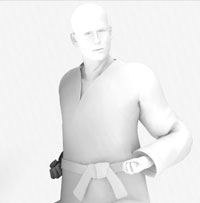
Training Safety Precautions
Overtraining can be described as a point where a person may have a decrease in performance and plateauing as a result from failure to consistently perform at a certain level or training load exceeds their recovery capacity. They cease making progress, and can even begin to lose strength and fitness. Overtraining is also known as chronic fatigue, burnout and overstress in athletes.
It is important to note the difference between overtraining and over-reaching; over-reaching is when an athlete is undergoing hard training but with adequate recovery, overtraining however, is when an athlete is undergoing hard training without the adequate recovery. View Overtraining »
* Please see a certified Master Instructor ( 사범님 sabeomnim ) for training. Proper guidance and instructions are needed to ensure safe training.
Advertisement

Did you know?
Taekwondo Summer Olympic Games

Taekwondo became a full medal sport at the 2000 Summer Olympics in Sydney, Australia, and has been a sport in the Olympic games since then. For Olympic competition, there will be a single elimination tournament for each of the weight categories. Repechage competition will occur for the bronze medal contest, while the winner of the tournament will receive the gold medal, and the loser will receive the silver medal. For more information View Taekwondo Summer Olympic Games »
| Year | Date | Flag | City | Host Country |
| 2020 |  |
Tokyo | Japan | |
| 2016 | August 5 -August 21 |  |
Rio de Janeiro | Brazil |
| 2012 | July 27 - August 12 |  |
London | United Kingdom |
| 2008 | August 8 - August 24 |  |
Beijing | China |
| 2004 | August 13 - August 29 |  |
Athens | Greece |
| 2000 | September 15 - October 1 |  |
Sydney | Australia |
RESOURCES
This article uses material from the Wikipedia article "Taekwondo at the Summer Olympics" which is released under the Creative Commons Attribution-Share-Alike License 3.0.
Horse-Riding Stance ( 주춤서기 juchum-sogi )
Footing Surface
Various surfaces of the foot may be engaged as the footing surface depending on which area of the body is being used. Proper footwork is used to enable the proper balancing of the body, to support combinations of strikes and launch strikes from the proper angle or distance. For more information on Impact Surface Areas »
( Click image for additional information)
Technique Injuries
Collisions with the ground, objects, and other taekwondo practitioners are common, and unexpected dynamic forces on limbs and joints can cause injury. Taekwondo injuries can also occur in techniques if done improperly or from overuse of a particular body part. Taking a break from training or reducing the volume and the intensity of the training will allow the body to recover. For more information on Injuries »
( Click image for additional information)
Common Mistakes when Performing the Technique
When performing the technique, there will be more mistakes as a beginner and as the practitioner advances through the rankings, they will have learned and improved from the past. How well one improves with training depends on several factors, such as the frequency it is engaged in, and the type of feedback that is available for improvement.
( Click image for additional information)
Some Techniques used in this Stance ( 서기 sogi )
An example of the union of mental and physical discipline is the combination of stance ( 서기 sogi ), footwork ( 딛기 ditgi ), and technique (either with block and/or strike), which requires both physical mastery of the technique and the concentration to focus one's power. Experienced practitioners learn through repetition and muscle memory when (not just how) to launch particular techniques, based on the circumstances they are facing.
( Click image for additional information)

Training Highlights Summary
The Stance ( 서기 sogi ) contains many key point highlights. There are some that are simple and straightforward but then some are complex and detailed that require repeated training to learn and master.
- is generally used to practice punches
- about two-foot length's apart
- distribute 50/50 weight ratio on the left and right legs
- the knees are deeply bent
- the shins should be kept slightly perpendicular to the floor
- wide stance with low center of gravity, giving stability
* Please see a certified Master Instructor ( 사범님 sabeomnim ) for training. Proper guidance and instructions are needed to ensure safe training.
Horse-Riding Stance ( 주춤서기 juchum-sogi )
Use in Sparring ( 겨루기 gyeorugi )
Under World Taekwondo (WT) and Olympic rules, sparring is a full-contact event and takes place between two competitors in an area measuring 8 meters square. A win can occur by points, or if one competitor is unable to continue (knockout) the other competitor wins. Points are awarded for permitted, accurate, and powerful techniques to the legal scoring areas; light contact does not score any points. For more information on World Taekwondo (WT) Tournament Sparring » 
( Click image for additional information)
Use in Self-Defense ( 호신술 hosinsool ) Applications
Self-Defense is to protect yourself from being attacked from would-be aggressors. It is a countermeasure that involves defending the health and well-being of oneself from harm and is designed primarily to cause injury or quickly incapacitate an attacker, in addition to being a deterrent against them. Attackers are typically larger, stronger, and are often armed or have an accomplice. With proper execution attackers may be incapacitated with a single blow, which lessens the number of attacks with multiple people. For more information on Self-Defense ( 호신술 hosinsool ) »
Practitioners must have their body weight correctly distributed during the stance ( 서기 sogi ) including proper footwork ( 딛기 ditgi ). Each technique must be correctly timed and aligned in order to defend effectively. The stance ( 서기 sogi ) is commonly performed during Self-Defense ( 호신술 hosinsool ) scenarios.
In self-defense ( 호신술 hosinsool ), it is used when being grappled in order to have a wider stance ( 서기 sogi ) and low center of gravity, giving stability and some control (compare with Judo and other wrestling defensive stances). The weight distribution of this stance ( 서기 sogi ) is 50/50 ratio and should be directed inwards. Short range punches ( 지르기 jireugi ) can be used on the target who is holding one around the waist when in this stance ( 서기 sogi ).
( Click image for additional information)
Use in One-Step Sparring
One-Step Sparring is performed with a partner in which predefined movements are practiced. One student is the attacker while the other student responds with defenses, counterattacks, and/or other actions, based on part of the predefined movements. For more information on One-Step Sparring »
The stance ( 서기 sogi ) is commonly featured during One-Step Sparring practice. Fundamentally, taekwondo One-Step Sparring is one of the learning grounds for real combat. As such, every technique including stance ( 서기 sogi ) must display the requisite speed, power and firmness to be realistically used as an attack or defense move. One-Step Sparring varies between schools.
( Click image for additional information)
Use in Breaking ( 격파 gyeokpa )
The discipline of destroying inanimate objects such as wooden boards, baseball bats, ice blocks or cement bricks and is a feature common to martial arts including taekwondo. A single board or stack of boards may be broken or, alternatively, a series of boards may be broken in a pre-set sequence utilizing a variety of strikes. Advanced competitors may even break several boards in a single jump with multiple kicks before landing. For more information on Breaking ( 격파 gyeokpa ) »
In use, the stance ( 서기 sogi ) is featured during Breaking ( 격파 gyeokpa ) events. General qualities that judges look for in any taekwondo practitioner include proper breathing technique and body control. The diaphragm must be engaged in deep breathing, shallow breathing concentrated in the upper abdomen results in raised shoulders and stressed muscles. Breaking ( 격파 gyeokpa ) varies between schools.
( Click image for additional information)
Advertisement
Horse-Riding Stance ( 주춤서기 juchum-sogi )
Use in Patterns ( 품새 poomse )
Stance is introduced in the following patterns:
TAEGEUK #: 7
BLACK BELT FORM: Koryo (1st Dan) Keumgang (2nd Dan)
Poomse is the foundation for the teaching of taekwondo. A poomse or form is a detailed pattern of defense-and-attack motions and techniques used in traditional martial arts. Poomse is useful in developing proper kinetics, mental and physical fortitude.
( Click image for additional information)
Most Kukkiwon 국기원 schools will use the poomse taegeuk whereas a few schools will use the poomse palgwe. The meanings, trigrams and symbols are shared by both poomse taegeuk and poomse palgwe, however the sequence of movements is different. The first 8 forms of the set of poomse differ from each other, whereas the last 9 forms (Black Belt forms) of the set are shared between the two sets. All students studying in World Taekwondo (WT) Kukkiwon style must learn these forms, or taegeuk, to advance to a higher belt level. There are eight taegeuk forms, each one similar to the previous one, but each time with more complicated techniques to display the students' mastery of the techniques learned during lessons, as well as the ability to interconnect these techniques.
For more information on taekwondo patterns refer to Poomse 품새 Section »
Learn other taekwondo stances on the Stance ( 서기 sogi ) Section »
Practitioners must have their body weight correctly distributed during each different stance and during footwork. Each technique must be correctly aligned. Every technique must display the requisite speed, power and firmness to be realistically used as an attack or defense move.
Use in Demonstrations
To promote taekwondo for its emphasis on high kicking and fast hand techniques, taekwondo schools perform at tournaments, community events, shopping malls, parks, and tv shows. Demonstrations vary from school to school, but may include such elements as the execution of poomse ( 품새 poomse ), which combine various techniques in specific sequences; the breaking of boards to demonstrate the ability to use techniques with both power and control; sparring ( 겨루기 gyeorugi ) and self-defense ( 호신술 hosinsool ) to demonstrate the practical application and control of techniques; physical fitness usually with push-ups and sit-ups. For more information on Demonstrations »
The stance ( 서기 sogi ) is commonly used in demonstration activities such as when performing poomse ( 품새 poomse ) which is the foundation for the teaching of taekwondo. A poomse ( 품새 poomse ) is a series of movements linked together in a prescribed sequence which is significant to demonstrate. As such, every technique must display the requisite speed, power and firmness to be realistically used as an attack or defense move.
( Click image for additional information)
Use in Warming-Up
A warm-up generally consists of a gradual increase in intensity in physical activity, joint mobility exercise, and stretching, followed by the activity. Warming-up brings the body to a condition at which it safely responds to nerve signals for quick and efficient action. For more information on Warming-Up »
In addition to being a stance ( 서기 sogi ) in itself, the stance ( 서기 sogi ) is an exercise used by many instructors to teach the principle of focusing, stretching, relaxing the muscles, increasing the range of motion and flexibility, something which is considered important in taekwondo. The result is a feeling of increased muscle control, flexibility and range of motion.
Dynamic stretching increases range of movement, blood and oxygen flow to soft tissues prior to exertion. Increasingly coaches and sports trainers are aware of the role in dynamic stretching in improving performance and reducing the risk of injury. Dynamic stretching works by the practitioner gently propelling their muscles towards their maximum range of motion.
In general, the practitioner wants to move (stretch) the muscle in a similar way that they are going to move them in a workout. For example a taekwondo practitioner who wants to stretch a hamstring ( 햄스트링 haemseuteuling ) for a kick ( 차기 chagi ) may swing a straight leg forward to gradually increase the height they can obtain. Doing light kicks, with little explosive acceleration, while gradually increasing height, could also be considered a dynamic stretch. For more information on Dynamic Stretching »
Risk of injury can be reduced by completing an effective warm-up consisting of a heart raiser to get your pulse up, followed by sport specific dynamic stretches (stretches whilst moving).
( Click image for additional information)
Horse-Riding Stance ( 주춤서기 juchum-sogi )

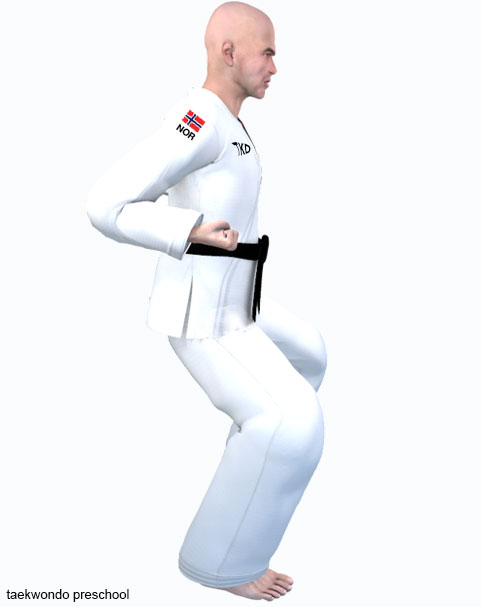
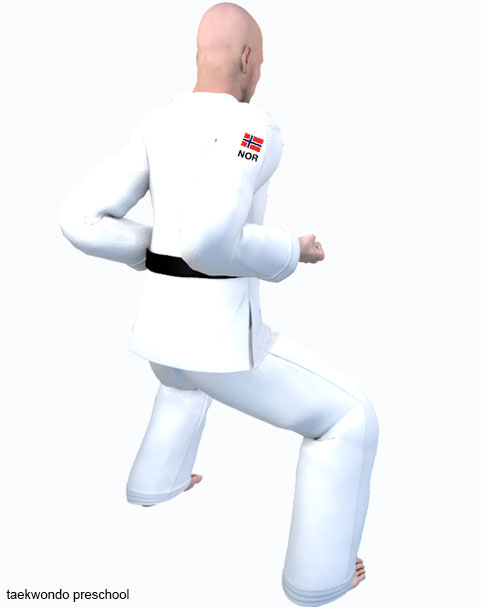
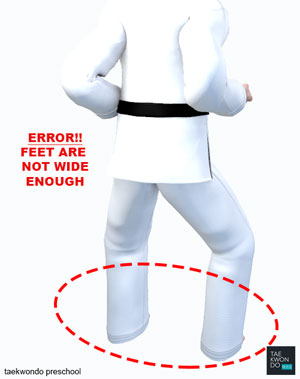
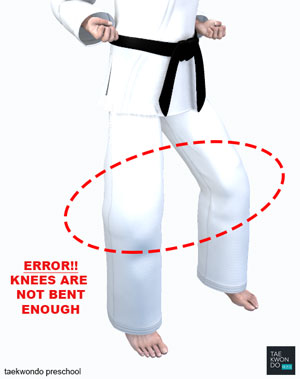
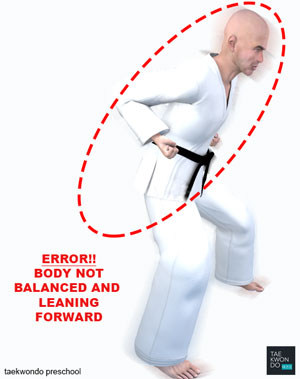
Additional Resources
Taekwondo Stances ( 서기 sogi )
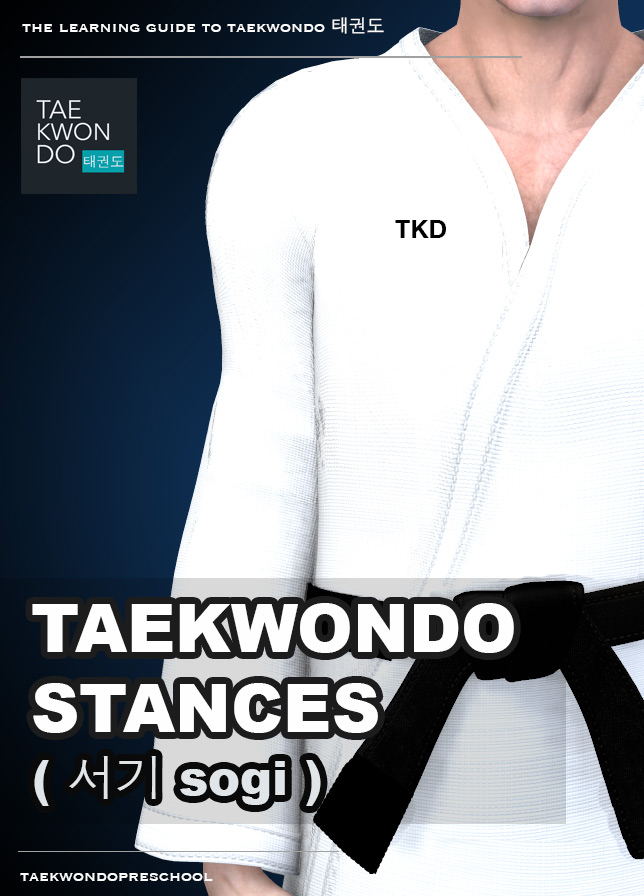
This book is available for download with Apple Books on your Mac or iOS device, and with iTunes on your computer. Book can be read with Apple Books on your Mac or iOS device.
The Korean martial arts taekwondo has several stances ( 서기 sogi ) used for different activities. Although there are strong similarities in stances ( 서기 sogi ) throughout taekwondo schools, individual instructors often have their own preferred style. These stances ( 서기 sogi ) are most commonly seen in taekwondo forms ( 품새 poomse ), and are critical for balance, precision, and good technique in the martial art.
View more information about Book »
TAEKWONDO STANCES ( 서기 sogi ) |
|||||
| Hangul 한글 | Korean | Belt Requirement | Difficulty Level | Tutorial | |
| Attention Stance | 차렷 | charyeot |   |
Beginner Level | Tutorial » |
| Ready Stance | 기본준비 | junbi |   |
Beginner Level | Tutorial » |
| Front Stance | 앞굽이 | ap-kubi |   |
Beginner Level | Tutorial » |
| Horse Riding Stance | 주춤서기 | juchum-sogi |   |
Beginner Level | Tutorial » |
| Two Fist Ready Posture | 두주먹허리준비 | dujumeok-heori-junbi |   |
Beginner Level | Tutorial » |
| Fighting Stance | 겨루기준비 | gyeorugi-junbi |    |
Beginner Level | Tutorial » |
| Walking Stance | 앞서기 | ap-sogi |   |
Beginner Level | Tutorial » |
| Parallel Stance | 나란히서기 | naranhi-sogi |   |
Beginner Level | Tutorial » |
| Inward Stance | 안쫑서기 | anjjong-sogi |   |
Beginner Level | Tutorial » |
| At Ease Stance | 편히서기 | pyeoni-sogi |   |
Beginner Level | Tutorial » |
| Back Stance | 뒷굽이 | dwi-kubi |    |
Intermediate Level | Tutorial » |
| Side Stance | 옆서기 | yeop-sogi |  |
Intermediate Level | |
| Left Stance ”L” Shape | 왼 서기 | wen-sogi |  |
Intermediate Level | Tutorial » |
| Right Stance ”L” Shape | 오른 서기 | oreun-sogi |  |
Intermediate Level | Tutorial » |
| Cross Stance | 꼬아서기 | koa-sogi |   |
Intermediate Level | |
| Rear Cross Stance | 뒤 꼬아서기 | dwi-koa-sogi |   |
Intermediate Level | Tutorial » |
| Covered Fist Posture | 보주먹준비 | bojumeok-junbi |  |
Intermediate Level | Tutorial » |
| Tiger / Cat Stance | 범서기 | beom-sogi |   |
Intermediate Level | Tutorial » |
| Forward Cross Stance | 앞 꼬아서기 | ap-koa-sogi |   |
Intermediate Level | Tutorial » |
| ‘ㅗ’ Shape Stance | ‘ㅗ’ 자 서기 | oja-sogi |   |
Advanced Level | |
| Log Pushing Hands Posture | 통밀기준비 | tongmilgi-junbi |   |
Advanced Level | Tutorial » |
| Crane Stance | 학다리서기 | hakdari-sogi |  |
Advanced Level | Tutorial » |
| Overlapped-Hand Posture | 겹손준비 | gyeopson-junbi |  |
Advanced Level | Tutorial » |
| Inner Knee Stance | 오금서기 | ogum-sogi |  |
Advanced Level | Tutorial » |
| Assisting Stance | 곁다리서기 | gyeotdari-sogi |  |
Advanced Level | Tutorial » |
Advertisement

Quiz
Question. What is the name of Taegeuk #8 in Korean?
Taegeuk 태극 (in World Taekwondo (WT)) refers to a set of poomse 품새 used to create a foundation for the teaching of taekwondo. A poomse or form is a detailed pattern of defense-and-attack motions and techniques used in traditional martial arts. Each taegeuk form symbolizes a specific state thought to be indicative of the belt the student currently holds, and is represented in World Taekwondo (WT) by trigrams similar to those found in the four corners of the South Korean flag.
Question. What is the name of Taegeuk #8 in Korean?
Answer you gave was: Chil Jang
Your answer is wrong! You need to study more!


The trigram associated with this poomse represents a Mountain. Also, it represents the northwest and youngest son. The symbolism behind the mountain is the indomitable and majestic nature that all mountains possess. This poomse is intended to be performed with the feeling that all movements are this majestic due to their unconquerable nature.
Question. What is the name of Taegeuk #8 in Korean?
Answer you gave was: Yuk Jang
Your answer is wrong! You need to study more!


The trigram associated with this poomse represents Water. Also, there is a relation to West and the relationship with a Second son. The movements of this poomse are intended to be performed like water; flowing, powerful and cleansing. Sometimes standing still like water in a lake, sometimes thriving as a river, sometimes powerful like a waterfall.
Question. What is the name of Taegeuk #8 in Korean?
Answer you gave was: Sam Jang
Your answer is wrong! You need to study more!
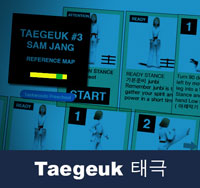

This trigram represents Fire. Related to this symbol is also East and the relationship of the Second Daughter. Fire contains a lot of energy. The symbol behind the fire is similar to the symbolism of the water in that both can aid and both can destroy. This form is intended to be performed rhythmically, with some outbursts of energy to reflect fire's rhythmic and energetic dualism.
Question. What is the name of Taegeuk #8 in Korean?
Answer you gave was: Pal Jang
Your answer is correct! Great Job!


The trigram associated with this poomse represents the Earth. Also, there is a representation of North and Mother. The associated trigram of this poomse is Yin. Yin, here, represents the end of the beginning, the evil part of all that is good. This being the last of the poomse Taegeuk, it represents the end of the circle and the cyclic nature of the Earth.
Question. What is the korean terminology for Back Stance?
Back stance is specifically focused on shifting weight to the back leg, as it offers much more control, and makes it easier to kick off the front leg. To perform this stance, the body faces to the side, with the front foot facing forward and the front leg bent. The back leg is bent slightly and the foot is turned outwards perpendicular to the front foot making the letter "L" for this stance.
Question. What is the korean terminology for Back Stance?
Answer you gave was: ( 뒷굽이 dwi kubi )
Your answer is correct! Great Job!
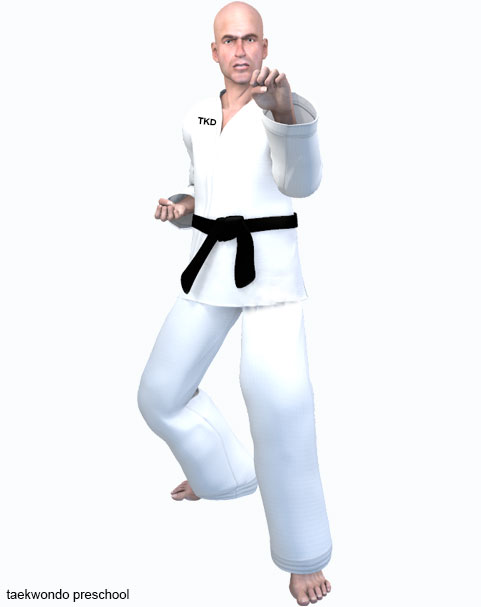
Back Stance ( 뒷굽이 dwi kubi ) is specifically focused on shifting weight to the back leg, as it offers much more control, and makes it easier to kick off the front leg. To perform the Back Stance ( 뒷굽이 dwi-kubi ), the body faces to the side, with the front foot facing forward and the front leg bent. The back leg is bent slightly and the foot is turned outwards perpendicular to the front foot making the letter "L" for this stance ( 서기 sogi ).
Question. What is the korean terminology for Back Stance?
Answer you gave was: ( 주춤서기 juchum sogi )
Your answer is wrong! You need to study more!
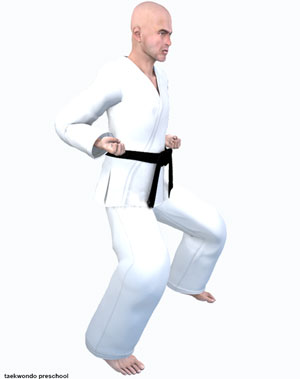
The Horse-Riding Stance ( 주춤서기 juchum-sogi ) is a beginner stance ( 서기 sogi ) generally used to practice punches ( 지르기 jireugi ) and blocks ( 막기 makgi ). It is similar to the Ready Stance ( 기본준비 junbi ) but the feet are placed much wider, about two-foot length's apart. Also, the knees ( 무릎 mureup ) are deeply bent and the shins ( 정강이 jeonggangi ) should be kept slightly perpendicular to the floor.
Question. What is the korean terminology for Back Stance?
Answer you gave was: ( 앞굽이 ap kubi )
Your answer is wrong! You need to study more!

Front Stance ( 앞굽이 ap-kubi ) is one of the most important techniques to learn when starting taekwondo as a beginner. The distance between the inside edges or namely the Reverse Foot Blade ( 발날등 balnaldeung ) of both feet should be between one to two fists apart and is about 4 to 4 one-half foot-length from origin. Rear toes are turned outward about 30 degrees and the body is also naturally angled at 30 degrees or facing straight forward depending on the upper body technique.
Question. What is the korean terminology for Back Stance?
Answer you gave was: ( 앞서기 ap sogi )
Your answer is wrong! You need to study more!
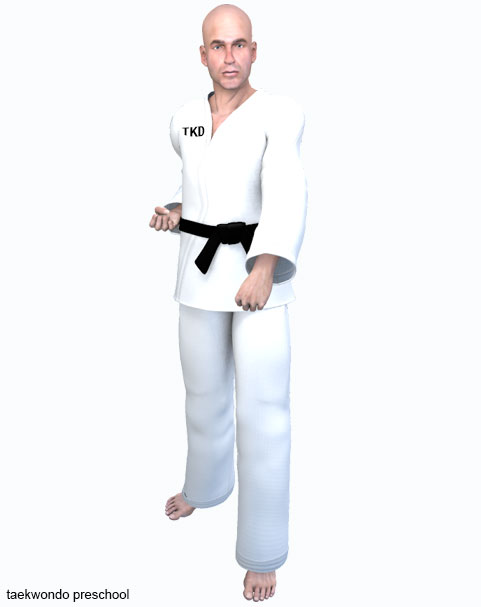
The Walking Stance ( 앞서기 ap-sogi ) is a beginner stance ( 서기 sogi ) that is used to approach or retreat in combat and patterns ( 품새 poomse ). Feet should be maintained approximately 3 foot-length from origin. To maintain a solid base, the front foot is facing straight forward and the back foot is 30 degrees to aid balance. Use of this stance ( 서기 sogi ) is featured prominently in many of the World Taekwondo (WT) Poomse.
Question. What is the korean terminology for Self-Defense?
Self-Defense is a countermeasure that involves defending the health and well-being of oneself from harm. Self-defense techniques and recommended behavior under the threat of violence is systematically taught in self-defense classes. It forms one of the main principles of the taekwondo art.
Question. What is the korean terminology for Self-Defense?
Answer you gave was: ( 지르기 jireugi )
Your answer is wrong! You need to study more!
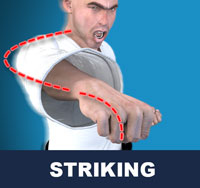

Taekwondo Fist Strikes ( 지르기 jireugi ) are performed as a close distance alternative to kicks ( 차기 chagi ). They are executed in a number of ways - from standing, jumping, spinning and rushing forwards. The striker relaxes to the extent possible during the strike, tensing the muscles of much of the body only at the time of impact, then relaxing again to recoil the striking part. Hand strikes make up fast combinations of strikes which can leave an opponent stunned and unable to defend himself most commonly in self defense ( 호신술 hosinsool ) applications.
Question. What is the korean terminology for Self-Defense?
Answer you gave was: ( 서기 sogi )
Your answer is wrong! You need to study more!
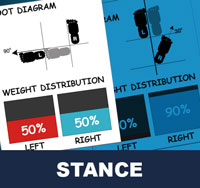

The Korean martial arts has several Stances ( 서기 sogi ) used for different activities. Although there are strong similarities in stances throughout taekwondo schools, individual instructors often have their own preferred style. These stances are most commonly seen in taekwondo forms, and are critical for balance, precision, and good technique in the martial art.
Question. What is the korean terminology for Self-Defense?
Answer you gave was: ( 호신술 hosinsool )
Your answer is correct! Great Job!
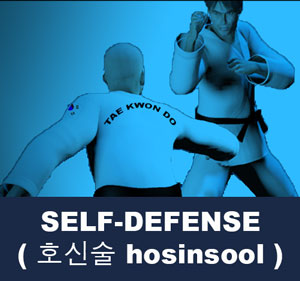

Self-Defense ( 호신술 hosinsool ) is a countermeasure that involves defending the health and well-being of oneself from harm. Self-defense techniques and recommended behavior under the threat of violence is systematically taught in self-defense ( 호신술 hosinsool ) classes. It forms one of the main principles of the taekwondo art. The self-defense ( 호신술 hosinsool ) applications would be difficult to score in sparring as they are designed primarily to cause injury or quickly incapacitate an adversary.
Question. What is the korean terminology for Self-Defense?
Answer you gave was: ( 치기 chigi )
Your answer is wrong! You need to study more!
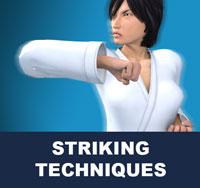

Taekwondo Strikes ( 치기 chigi ) are performed as a close distance alternative to kicks. Hand strikes make up fast combinations of strikes which can leave an opponent stunned and unable to defend himself. Striking ( 치기 chigi ) are taekwondo techniques striking with the twisting force of the body excluding techniques using the fist ( 주먹 jumeok ) or fingertips ( 손끝 sonkkeut ).
Question. What is the name of Taegeuk #7 in Korean?
Taegeuk 태극 (in World Taekwondo (WT)) refers to a set of poomse 품새 used to create a foundation for the teaching of taekwondo. A poomse or form is a detailed pattern of defense-and-attack motions and techniques used in traditional martial arts. Each taegeuk form symbolizes a specific state thought to be indicative of the belt the student currently holds, and is represented in World Taekwondo (WT) by trigrams similar to those found in the four corners of the South Korean flag.
Question. What is the name of Taegeuk #7 in Korean?
Answer you gave was: Yuk Jang
Your answer is wrong! You need to study more!


The trigram associated with this poomse represents Water. Also, there is a relation to West and the relationship with a Second son. The movements of this poomse are intended to be performed like water; flowing, powerful and cleansing. Sometimes standing still like water in a lake, sometimes thriving as a river, sometimes powerful like a waterfall.
Question. What is the name of Taegeuk #7 in Korean?
Answer you gave was: Sa Jang
Your answer is wrong! You need to study more!


This trigram represents Thunder. Also, the trigram is strongly connected to northeast and the relationship of the Eldest son. Thunder comes from the sky and is absorbed by the earth, thus, according to the beliefs of the I Ching, thunder is one of the most powerful natural forces. This poomse is associated with power and the connection between the heavens and earth.
Question. What is the name of Taegeuk #7 in Korean?
Answer you gave was: O Jang
Your answer is wrong! You need to study more!


The trigram associated with this poomse represents Wind. The trigram is also related to southwest and the relationship with an eldest daughter. The I Ching promotes that wind is a gentle force, but can sometimes be furious, destroying everything in its path. As such, it is intended that this poomse is performed like the wind: gently, but knowing the ability of mass destruction with a single movement.
Question. What is the name of Taegeuk #7 in Korean?
Answer you gave was: Chil Jang
Your answer is correct! Great Job!


The trigram associated with this poomse represents a Mountain. Also, it represents the northwest and youngest son. The symbolism behind the mountain is the indomitable and majestic nature that all mountains possess. This poomse is intended to be performed with the feeling that all movements are this majestic due to their unconquerable nature.


Related Articles
The korean martial arts taekwondo has several stances ( 서기 sogi ) used for different activities. Practitioners must have their body weight correctly distributed during each different stance and during footwork. Each technique must be correctly aligned. Although there are strong similarities in stances throughout taekwondo schools, individual instructors often have their own preferred style. For information View Taekwondo Stances ( 서기 sogi ) »
- Ready Stance ( 기본준비 junbi )
- Walking Stance ( 앞서기 ap-sogi )
- Front Stance ( 앞굽이 ap-kubi )
- Attention Stance ( 차렷 charyeot )
- Fighting Stance ( 겨루기준비 gyeorugi-junbi )
- Parallel Stance ( 나란히서기 naranhi-sogi )
- Horse Stance ( 주춤서기 juchum-sogi )
- Back Stance ( 뒷굽이 dwi-kubi )
- Covered Fist Ready Stance ( 보주먹준비 bojumeok-junbi )
- Log Pushing Posture ( 통밀기준비 tongmilgi-junbi )
- Overlapping Hand Posture ( 겹손준비 gyeopson-junbi )
- Assisted Stance ( 곁다리서기 gyeotdari-sogi )
- Inward Stance ( 안쫑서기 anjjong-sogi )
- Left Side Stance ( 왼 서기 wen-sogi )
- Right Side Stance ( 오른 서기 oreun-sogi )
- Cat Stance ( 범서기 beom-sogi )
- Forward Cross Stance ( 앞 꼬아서기 ap-koa-sogi )
- Rear Cross Stance ( 뒤 꼬아서기 dwi-koa-sogi )
- Crane Stance ( 학다리서기 hakdari-sogi )
- Inner Knee Stance ( 오금서기 ogum-sogi )
- Two Fist Ready Stance ( 두주먹허리준비 dujumeok-heori-junbi )
- At Ease Stance ( 편히서기 pyeoni-sogi )
- Closed Stance ( 모아서기 moa-sogi )
- Forward Riding Stance ( 앞 주춤서기 ap-juchum-sogi )
There are five tenets defined in the International Taekwondo Federation (ITF) and several more in World Taekwondo (WT).
Integrity ( Yeom Chi / 염치 ): "Although it may be similar, this form of integrity takes on a more wider role then defined in the common dictionary. In taekwondo, integrity means not only to determine what is right or wrong but also having the conscience to feel guilt if one has done wrong and to have the integrity stand up for what is right." View Taekwondo Tenets »
RESOURCES
This article uses material from the Wikipedia article "Taekwondo Stances", which is released under the Creative Commons Attribution-Share-Alike License 3.0.





